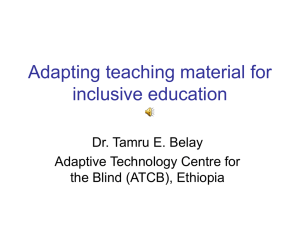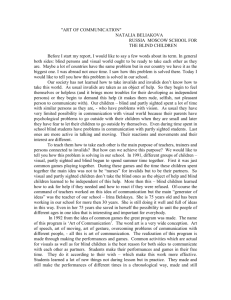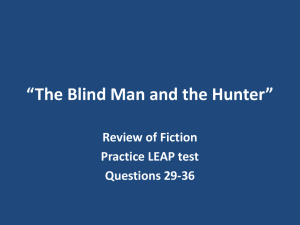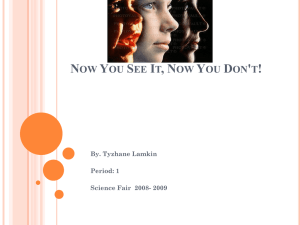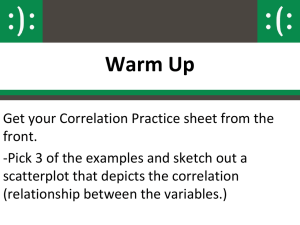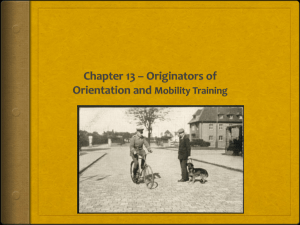Overview few blind people attain a high level of
advertisement
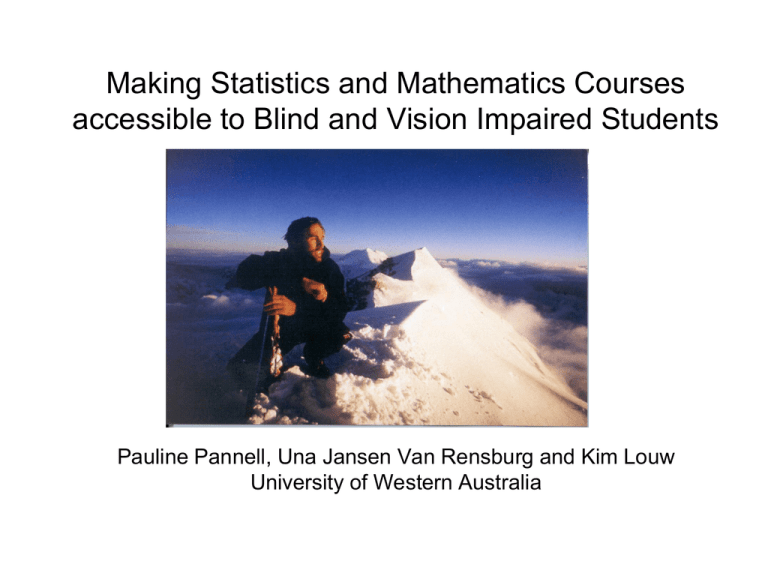
Making Statistics and Mathematics Courses accessible to Blind and Vision Impaired Students Pauline Pannell, Una Jansen Van Rensburg and Kim Louw University of Western Australia Overview Few blind people achieve in higher mathematics Making math and stat more accessible Which strategy to adopt? Case Study. Una learns Statistics Short Film: teaching SPSS Using Code Useful distinction for our purposes is between people who are vision impaired, including the legally blind who may be able to use some vision in accessing learning materials and those who need to rely totally on non visual means to access information. Different learning style Superior tactile, auditory discrimination, verbal processing, memory span and long term memory Disadvantaged in spatial learning. Spatial information becomes a series of items. Source: Pasqualotto, A and Proulx, M. (2012) The role of visual experience for the neural basis of spatial cognition. Neuroscience and Biobehavioral Reviews (36) 1179-1187 Congenitally Blind Differ from Acquired Blind. May still be able to visualise Source: Figueiras, L and Arcavi, A 2014 A touch of mathematics. Coming to our senses by observing the visually impaired. Mathematics Education (46) 123-133. MUCH bigger demand on working memory for both low and vision impaired and blind: Information gained in series of chunks Either haptic, auditory or visual Experiential Exercise for You Close your eyes Road Blocks to Learning Notation not accessible by screen reader or Braille Numerical and statistical reasoning depends on conveying visual and spatial features…example standard deviation Statistics is Spatial Blocking the Road to Learning Academics can’t or won’t adapt teaching style: use of vague verbal directional cues …look over here Mental Fatigue Total additional time required to access course Sources: Spindler, R. (2006) Teaching mathematics to a student who is blind. Teaching Mathematics and its Applications (25) 3 120-126. Gibson W.E and Darron C. (1999) Teaching statistics to a student who is blind. Teaching of Psychology. (26) 13-131. Improving Access Clay, wood, paper models, puff paint Tactile embossing print technology with associated software Pictures in a flash (raised line drawings on swell paper) 2d and 3d models are effective tools for conveying spatial concept but time consuming http://www.uncp.edu/academics/colleges-schools-departments/departments/sociology-and-criminal-justice/visualimpairment-and-teaching-statistics/directions-construction-teaching-artifacts http://mathslinks.net/faculty/normal-distribution-foldable Improving Access Braille code to Latex and vice versa Universal Braille code for mathematics (LAMBDA project) Edwards, A. McCartney, H. and Fogarolo F. (2006) Lambda: A multimodal approach to making mathematics accessible to blind students. Translation of mathematical notation into words and captioning of graphics for screen readers Course delivered and assessed over extended time Improving Access Open book assessment Untimed assessment Academics must be educated, coaxed to adopt accessible teaching style Proctor or sighted education assistant Lonnie Bedwell blind white water paddler 226-mile, 16-day journey on Colarado River http://www.grindtv.com/outdoor/excursions/post/veteran-becomes-firstblind-kayaker-to-paddle-grand-canyon/ Role Sighted Education Assistant Competent in the subject Convert teaching materials Develop a repertoire of shared meaning Plan for replacement May also become tutor Assist in exam Role clarity Which strategy to adopt? Student’s background in math/stat Which technology depends on: students current technology capacity to learn new technology time to adopt or learn technology interface between technologies Level of staff input Availability of skilled staff to provide training and support Una Jansen Van Rensburg Student UWA Background Double major in Psychology 2012-2015 Normal sight up to age 21 Maths up to Year 12 Algebra versus geometry Visual and spatial strength Screenreader JAWS (others e.g. Window Eyes, NVDA, Zoomtext) Making the course accessible First challenges What to expect Making use of sighted assistants Started preparation before semester Meeting the needs evolved over time Inaccessibilities and Solutions Textbook and lecture slides Greek symbols Graphic images and graphs Inaccessibilities and Solutions Lectures “A picture speaks a thousand words”…?? Think of line graph of the normal distribution Formulae: close eyes for an example Formula for Standard Deviation Sentence wording of formulae eg: S = square root of: sum of (x minus mean of x) squared, everything over n minus 1 Talking calculator Calculator in SPSS software Assistant and Student Interaction Conversion and editing of lecture slides (write out symbols as words, describe images) Student commitment Time with assistant Graphs: tracing/drawing on plastic/embossed printer SPSS (Statistics software) Lab Exam Part of Unit Assessment Time pressure in labs JAWS not reliable Output window not accessible Transport to Excel necessary Locate Excel file, locate table, locate cell (time!) Workable Strategy View lab slides beforehand Attend and listen Do analysis afterwards with sighted assistant Timed Lab exam demonstrating SPSS skills DIFFICULT A Solution for analyses…. Only take stats if essential Career counselling and course planning Stay motivated Extra time units require double or more time clarifying lecture material explanation of visuals repeat of lab sessions Consider doing few units per semester It can be done! Conclusions Student intellectual and emotional resilience Collaborative and engaged teaching staff early learning materials Equity staff commitment Acknowledgements Antony Gray Kim Louw Short film can be viewed at http://youtu.be/6EwbhDFZpUM 'bonus' video, which you can find here: http://youtu.be/UEUQmLMK2_M

